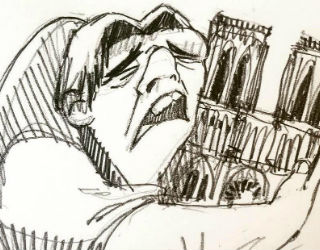
Notre Dame: How the Hunchback of Notre Dame Got His Name
FREE Catholic Classes
As fire ravaged the roof of Notre Dame Cathedral in Paris earlier this month, one artist from Ecuador used her skills to express the grief that she and so many people throughout the world felt as the beautiful building burned.

Artist Cristina Correa Freile drew up Quasimodo holding the Notre Dame Cathedral after the fires.
Highlights
Catholic Online (https://www.catholic.org)
4/29/2019 (6 years ago)
Published in Europe
Keywords: Quasimodo, Hunchback of Notre Dame, Divine Mercy Sunday, Victor Hugo
Paris, France (CNA) - In a pencil sketch posted to Instagram that quickly went viral, artist Cristina Correa Freile depicted Disney's version of Quasimodo, the famous fictional "Hunchback of Notre Dame", crying and hugging the beloved church where he was the bellringer.
Quasimodo was the hero of a novel by Victor Hugo, written at another time when Notre Dame needed saving, from years of destruction and disrepair. Given the emotional reaction to the sketch from thousands who saw it, the beloved character may be at least part of the reason that people once more rally behind the restoration of Notre Dame de Paris.
Because the name "Quasimodo" is most frequently associated with an ugly but lovable character from a fictional story, some may be surprised to learn that the hunchback's name is actually liturgical.
In Hugo's novel, Quasimodo, rejected by his parents for his deformities, is abandoned inside Notre Dame Cathedral, at a place where orphans and unwanted children were dropped off.
Monseigneur Claude Frollo finds the child on "Quasimodo Sunday" and "called him Quasimodo; whether it was that he chose thereby to commemorate the day when he had found him, or that he meant to mark by that name how incomplete and imperfectly molded the poor little creature was," Hugo wrote.
Quasimodo is the Latin name for the Sunday following Easter. It is drawn from the first words of the entrance antiphon for the day, which is the chant sung as the priest approaches the altar for Mass. The entrance antiphon (also called the Introit) for Quasimodo Sunday begins with: "Like newborn infants," or, in Latin, "quasi modo geniti infantes."
The full chant, drawn from 1 Peter 2:2, is as follows: "As newborn babes, desire the rational milk without guile, that thereby you may grow unto salvation: If so be you have tasted that the Lord is sweet."
On this Sunday, also known as Low Sunday, Catholics are called to remember the newest members of the Church.
"It counsels the first communicant or the convert, likened to a newborn child, to desire the milk of the mother, to receive that nourishment and grow. Properly disposed, the new communicant doesn't need to be told this. But the rest of us sing about this as a reminder that there are children among us who need to be cared for, and that we all should preserve the spirit of the children of God and remain humble and submissive to the Divine Will," according to an explanation from the New Liturgical Movement website.
Today, the Sunday following Easter is typically remembered as "Divine Mercy Sunday," a feast day established by Pope John Paul II which honors the divine mercy of Jesus, as called for in the diary of St. Faustina Kowalska, a Polish nun who received revelations of Jesus, and wrote down his words in her diary. St. Faustina was canonized by Pope John Paul II in 2000.
---
'Help Give every Student and Teacher FREE resources for a world-class Moral Catholic Education'
Copyright 2021 - Distributed by Catholic Online
Join the Movement
When you sign up below, you don't just join an email list - you're joining an entire movement for Free world class Catholic education.
An Urgent Message from Sister Sara – Please Watch
- Advent / Christmas
- 7 Morning Prayers
- Mysteries of the Rosary
- Litany of the Bl. Virgin Mary
- Popular Saints
- Popular Prayers
- Female Saints
- Saint Feast Days by Month
- Stations of the Cross
- St. Francis of Assisi
- St. Michael the Archangel
- The Apostles' Creed
- Unfailing Prayer to St. Anthony
- Pray the Rosary
![]()
Copyright 2025 Catholic Online. All materials contained on this site, whether written, audible or visual are the exclusive property of Catholic Online and are protected under U.S. and International copyright laws, © Copyright 2025 Catholic Online. Any unauthorized use, without prior written consent of Catholic Online is strictly forbidden and prohibited.
Catholic Online is a Project of Your Catholic Voice Foundation, a Not-for-Profit Corporation. Your Catholic Voice Foundation has been granted a recognition of tax exemption under Section 501(c)(3) of the Internal Revenue Code. Federal Tax Identification Number: 81-0596847. Your gift is tax-deductible as allowed by law.







